|
Saturday, July 10th
I’m leaving
Kyoto today. It’s a short walk to Kyoto Station, and then Shinkansen to Osaka.
It only take 15 minutes. Then I change train, for another Shinkansen heading for
Hiroshima.
|
I
check in to another ok Toyoko-Inn Hotel. I can save a little bit by
getting a member, so I do.
Hiroshima is known for one thing in the history-books. The first A-bomb.
There’s a memorial park down by the river. I take the tram down there.
The first thing I see is Grebaku Domemae – or A-bomb Dome. That’s the
only building left from the bomb. The old industrial building was about
100 meter from the place the bomb hit, and the only one surviving. About
140.000 people in Hiroshima didn’t.
Then
I head for the peace-park with numerous monuments. The central monument
for the victims is surprisingly small. |
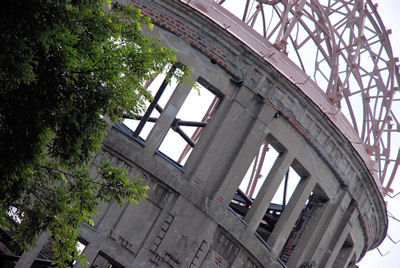 |
 |
Finally I head for the Peace-Museum. They tell you the story, and it’s
an interesting museum. There are quite a lot of people inside. Down in
the basement there's a special exhibition. I'm almost alone down there
watching an exhibition made out of pictures from a local who has
followed different places in Hiroshima – from the bomb fell to
everything was fixed, several years later.
Then
I retrace my steps through the pretty modern city of Hiroshima, back to
my hotel, close to the station.
There’s a short break at the hotel, before heading for dinner in the
local neighbourhood. As usual it’s pretty easy to find a good place. I
have never before been anywhere where getting good food is so easy. |
Sunday,
July 11th
|
I
have planned a daytrip to Miyajima south of Hiroshima. But there are
very dark clouds around – and I’m also a bit concerned that it’s a
tourist-trap.
Instead I spend the day seeing some semi-sights in Hiroshima. This is
done in rainy conditions, and I have to buy myself a new see-through
plastic umbrella, instead of the cheap one that has followed me for many
years. But this is too much for the old one – I have to leave it at a
wastebasket.
The
first semi-sight is Shukkeien. That’s an old Japanese garden from 1620.
Next semi-sight is Hiroshima Castle. Only the tower is left, and it was
rebuilt in 1958. Inside there’s a museum and lots of Samurai-swords.
From the top there’s a nice view. |
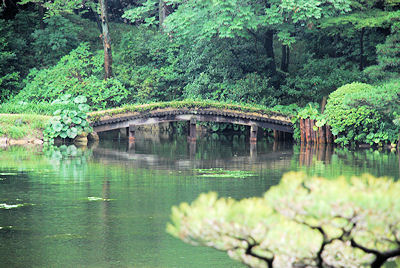 |
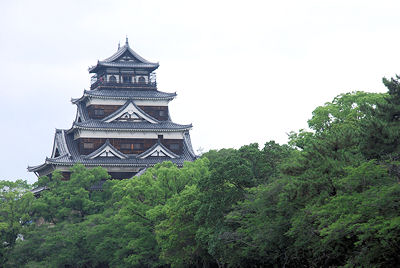 |
These 2 sights and a walk through Hiroshima will make up for the
sightseeing today.
In
the evening I visit a local pachinko-parlour. The noise is enormous. You
have to get some small metal-balls through a small hole in the middle of
the machine. Then you get a feature-game. Some wheels will be turning
then, and maybe you win – maybe you don’t. I don’t know how. But
suddenly I win. My machine goes crazy. I win a lot of new metal-balls. I
fill up 2 red plastic-boxes with all the metal-balls. Call for help.
Someone come to get my boxes. Take me to another machine. I get a
receipt. Go to the cashier – and gets…..2 boxes of small chocolate, and
some plastic things. But the plastic things is the trick. I’m followed
out of the hall, through a dark alley to a place where there is another
cashier hidden in the wall. I stick my plastic things through the hole –
and get 8.200 Yen back. This is how they handle the ban against
gambling. |
Monday, July 12th
I’m leaving
Hiroshima at 8.15 on a Shinkansen-train to Osaka. From there it’s another
Shinkansen to Nagoya. This is where there should be a train for Takayama, but it
is cancelled due to bad weather on the line. But the next one – an hour later –
runs almost on time.
|
Takayama is an old historic city in the Japanese Alps. The train-ride is
nice. Most of it runs along a river that is going crazy because of the
rain the last few days.
Video - River towards Takayama
I
check into Super Hotel. It’s ok – but not exactly super. The rooms are
very small. But it’s dead-cheap. I start by taking a nap, because I had
to wake up in the middle of the night in Hiroshima, to watch the world
cup final.
Later I take a stroll around Takayama. Some of the streets and houses
are very old. The old houses are made out of dark wood. Just what you
would expect from an old Kurosawa-movie – or from Shogun. Dinner is at a
local noodle-shop. Dead-cheap as well. |
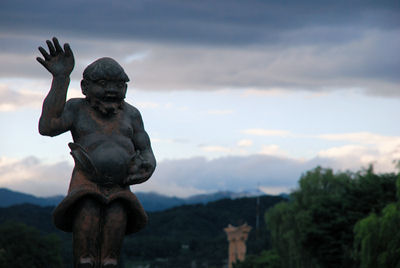 |
Tuesday,
July 13th
 |
It
is massive rain today in Takayama, so my new umbrella has to do the job.
I start the day at Takayamajinja close to my hotel. That’s the old home
of the Kanamori-clan, from where the local Shogun controlled the area.
It’s a nice place, with a huge barn built for all the rice the guy could
get as taxes.
From
there I walk to Sanmachisuji – an area with old timber-houses. Then I
head for a small museum-area in the north-eastern part of Takayama. |
|
Among others I visit the Shishi Kaikan, where they demonstrate Karakuri,
which is an old mechanical puppet-theatre. It’s pretty fun. We are only
3 in the audience. I also visit Yatai Keikan, which houses some of the
fleets that are used annually for a huge parade through the city.
Finally there’s the Sakurayama Hachimangu – an old shrine. From there I
walk through the rainy streets of Takayama back to my hotel with a
lunch-stop on the way.
Later I visit Hida
Kukubinji. That’s the oldest temple in Takayama. It’s
closed when I get there, so I can only watch from the outside. Dinner is
a local Izakaya, where they serve traditional Japanese food. Finally a
stroll through Sanmachisuji in the evening, to see if I can get any good
pictures by dark. |
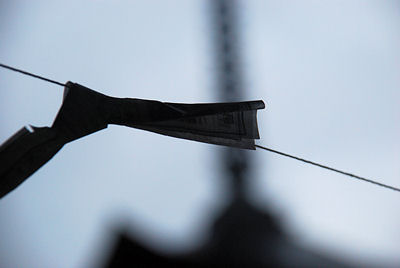 |
Wednesday, July 14th
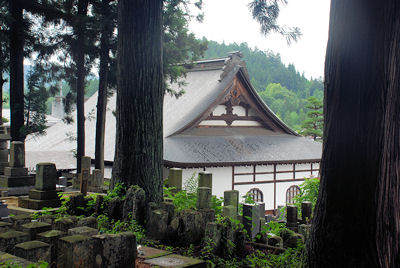 |
Another day of rain in Takayama. Not as much as yesterday – but anyway.
First stop today is Hida Kulubinji, hoping the temple is open. It is
not. Then down to the Miyagawa River. There’s a market where the country
people are selling radishes, cucumbers etc. Then on to Kusakabe
Mingaikan. That’s an old home for a local business-man – now turned into
a museum. Here you see how the semi-rich lived 100 years ago. |
|
Then
out into the forest at the outskirts of Takayama. Out here in the area
between city and mountains – called Higashiyama – there are small
temples dotted all over. There’s a nice walk with a new temple around
each corner. You also cross Buddhist cemeteries and places with nice
views of Takayama and the mountains. There are very few tourists out
here. I think I only meet a handful on my walk. Finally I head back into
city, and stroll around more tourist-free areas, before heading to
Sanmachisuji, where all the tourists seem to have gathered.
This
is the tourist-activity of today. The rest of the day is relaxation.
Dinner is at a BBQ down at the railway-station. On the TV they have a
rerun of Japan vs. Denmark. That’s not what I need. |
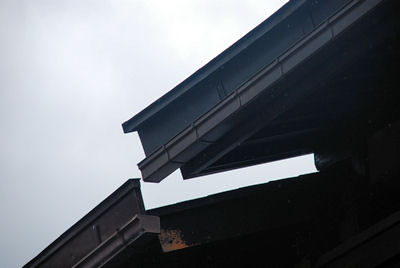 |
Thursday,
July 15th
There are
still problems on the train-line between Nagoya and Toyama due to the huge
amount of rain the last few days. My 11 o’clock train arrives at noon, and is
even more delayed on my way to Toyama. When you see the river that the rail
tracks follow on most of the route you will understand why. It’s even top story
in the news on TV.
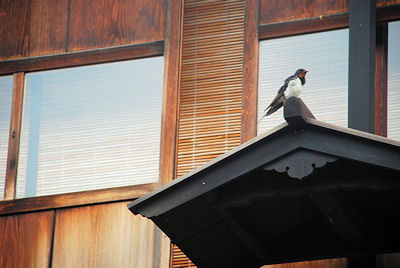 |
I
Toyama I board a train for Kanazawa. Im there at about 2 pm. Then
there’s the short walk to my Toyoko Inn, where I will stay for 2 nights
in room 318.
Kanazawa has about 500.000 inhabitants. There’s a famous garden and some
old neighbourhoods. After a late lunch I head for one of them. It’s
called Higashi Chayagai. There are some small streets with houses made
of dark wood. The Geishas used to entertain here back in the 19th
century. There’s a small museum in one of the houses, showing the life
of a Geisha. You can visit if you take off your shoes. I take a bus back
to the hotel. As a special tonight there is free dinner at the hotel –
curry and rice. On the telly there is golf from St. Andrews. |
Friday,
July 16th
|
The
rain has disappeared – and temperatures have risen to 33 degrees
Celsius.
So
the first walk is a hot one. First it’s 3 different neighbourhoods. The
first one is Nagamachi. It’s an old Samurai-area, with old
Samurai-houses and of course a Samurai-Museum.
The
next one is Katamachi. That’s the “red light district”. On a Friday
morning there’s not much red light around.
The
last one is on the other side of the river Saigawa. It’s called
Teramachi. There are a few more temples here.
. |
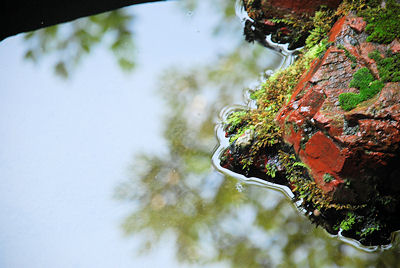 |
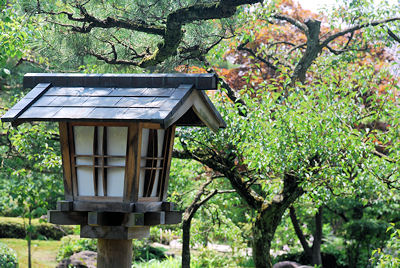 |
Then
I head on for the big sight in Kanazawa. That’s the huge park or garden
called Kenkuroen. I'm not an expert into Japanese gardens, but I think
this one is nice. There seems to be a spot in the park that is
especially famous. All people gather here to have a photo taken.
Finally I head back home. I pass the Omicho-market on the way with
exotic fruits and strange fish.
The
evening walk will be at my local area and finishes with a great dinner
at a local restaurant I have found. Back at the hotel I sit at the
window and watch a huge thunderstorm passing Kanazawa.
Video - Thunderstorm in Kanazawa |
|
Saturday, July 17th
I’m
leaving Kanazawa at 9 am on an express-train. I change to a local train
in Naoetsu. So I arrive in Nagano at 1.30. Another short walk to my
Toyoko Inn here. Nagano was host to the Winter-Olympics in 1998. There
are not many sights, but a good place for a few daytrips.
There is one famous sight though. I check that out this afternoon. It’s
called Zenkuji. It’s a temple that was established in the 7th
century. It has burned to the ground a few times. The one standing now
is form the 17th century. There are 2 impressive gates before
you actually reach the temple. For once it’s not only tourists here –
there are worshippers as well. It’s a place you have to visit if you are
a true Buddhist.
This
completes today's sightseeing. The rest of the day is spent on relaxing
and dinner at Pronto’s. |
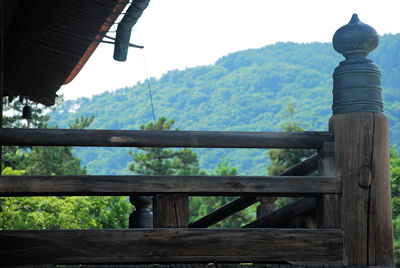 |
Sunday,
July 18th
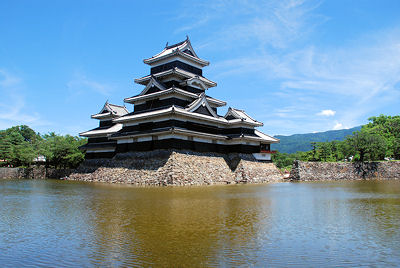 |
Daytrip to Matsumoto. Because of the high temperatures I start up early
in the morning. First I take a slow train. It takes about 70 minutes to
reach Matsumoto. Matsumoto is a very orderly city, where the main
attraction is Matsumotojo – or Matsumoto Castle. The castle is built
like a temple with 6 floors – all made out of heave wood. It was built
back in 1595 and looks very majestic. It is located with water
surrounding on all sides and just one bridge to cross. The castle has
small holes used for defence as well. You could shoot arrows after
intruders – or simply throw huge stones down from the 4th
floor at anyone trying to get in.
|
|
These days it’s easier to get inside. You just have to queue up and
leave 600 Yen at the entrance. But then trouble starts. Inside its all
one long line of people on the steep stairs and it is very slow. But
it’s also very impressive – one of the most impressive sights on this
trip.
After this I spend a couple of hours in downtown Matsumoto, before I
head back home to Nagano on an express-train.
In
Nagano it’s time to do my laundry at the hotel. This gives me the time
to finish the book I have brought for this trip as well. |
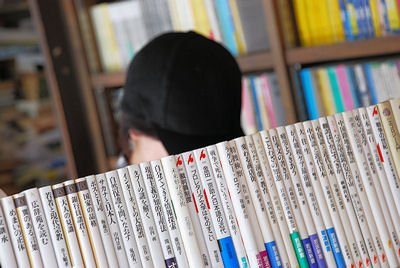 |
Monday,
July 19th
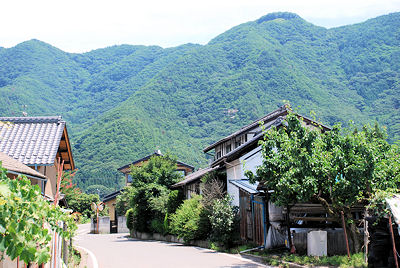 |
Another daytrip today. This time with a Nagodan-train to Obuse. That’s a
small village north-east of Nagano. This place is chosen to get a little
out into the countryside – and there are a few attractions as well.
One
of them is Hakusaikan. That’s a museum with an exhibition of art by
Hakusai. He lived from 1760 to 1849 and according to information at the
museum he was very famous. And that’s probably right.
|
|
After visiting the museum I head for a walk to the mountains. There are
apple orchards and vineyards on the way out there. I didn’t know they
made wine in Japan – except for Sake – Rice wine. But on the other hand
– they also make Whiskey. Just where the mountains start, there’s a
neatly little temple. My guide book doesn’t know what it is – and all
signs are in Japanese – but nevertheless it’s very nice.
After a few hours out here I head back to Nagano by train.
Later I have the time for a short walk around Nagano. The city centre is
full of hotels and shops. That’s nothing for me. Dinner is at a local
place. Something exiting with rice, beans, rice, bean sprouts, rice,
some meat and a little more rice. |
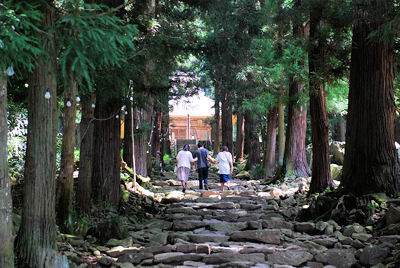 |
To Tokyo |
















